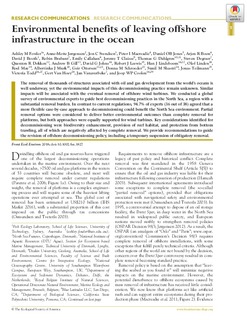Environmental benefits of leaving offshore infrastructure in the ocean
Fowler, Ashley M.; Jørgensen, Anne-Mette; Svendsen, Jon C.; Macreadie, Peter I.; Jones, Daniel O.B.; Boon, Arjen R.; Booth, David J.; Brabant, Robin; Callahan, Emily; Claisse, Jeremy T.; Dahlgren, Thomas G.; Degraer, Steven; Dokken, Quenton R.; Gill, Andrew B.; Johns, David G.; Leewis, Robert J.; Lindeboom, Han J.; Linden, Olof; May, Roelof Frans; Murk, Albertinka J.; Ottersen, Geir; Schroeder, Donna M.; Shastri, Sunil M.; Teilmann, Jonas; Todd, Victoria; Hoey, Gert Van; Vanaverbeke, Jan; Coolen, Joop W.P.
Journal article, Peer reviewed
Published version

Åpne
Permanent lenke
http://hdl.handle.net/11250/2505018Utgivelsesdato
2018Metadata
Vis full innførselSamlinger
- Publikasjoner fra CRIStin - NINA [2364]
- Scientific publications [1392]
Originalversjon
10.1002/fee.1827Sammendrag
The removal of thousands of structures associated with oil and gas development from the world’s oceans is well underway, yet the environmental impacts of this decommissioning practice remain unknown. Similar impacts will be associated with the eventual removal of offshore wind turbines. We conducted a global survey of environmental experts to guide best decommissioning practices in the North Sea, a region with a substantial removal burden. In contrast to current regulations, 94.7% of experts (36 out of 38) agreed that a more flexible case-by-case approach to decommissioning could benefit the North Sea environment. Partial removal options were considered to deliver better environmental outcomes than complete removal for platforms, but both approaches were equally supported for wind turbines. Key considerations identified for decommissioning were biodiversity enhancement, provision of reef habitat, and protection from bottom trawling, all of which are negatively affected by complete removal. We provide recommendations to guide the revision of offshore decommissioning policy, including a temporary suspension of obligatory removal.
